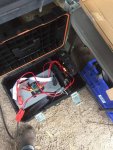So after reading many different forums, thoughts and ideas I did something like the $50 set up... but kind of blew the budget...
I knew what I wanted to achieve, which was a non-permanent set up that is movable between the car and the camper trailer, with a solar input for when it's in the camper.
So I worked out what I had and what I needed, found a
circuit diagram drawing package and sketched up this:

From that I went shopping at eBay, local parts shops and the hardware store:

All of that got tested over a weekend away to make sure it worked, with it all resembling an IED:

And then tidied up once we got back, with all the bits attached to a piece of MDF, all connections heat shrunk and holes drilled in the box.

What I used:
-1x 130AH AGM Battery (AU$240)
-1x Projecta IDC25S DC/DC and Solar charger (with inbuilt MPPT solar doohickey) (AU$220)
-2x 50A manual reset circuit breakers (AU$10 ea)
-2x Red Anderson (Narva version) plugs for the solar lead input; the alternator input (which is not wired up yet, will run in via Grey plugs and a 50A circuit breaker under the bonnet) (AU$10ea)
-1x Bus Bar for the negatives (AU$20)
-1x 4 fuse fuse box for the pod on the top (AU$15 + $40)
-Lost track of how much cable - about 2 metres of 8B&S is in the box I reckon, and 10m of twin core 8B&S is on the solar feed cable (AU$90)
-1x small cable gland as a breather ($2)
-1x 26mm cable gland as the route in for the solar input ($2)
-1x Big toolbox (Tactix seem to be identical to a load of other ones that are available from a number of different manufactures) ($60)
I think that's the lot...
All up, including the battery and DC/DC charger, I think it came in at around AU$730... so a touch more then getting something off the shelf, but I knew what I was getting, how it works and what I need to do to fix it.





